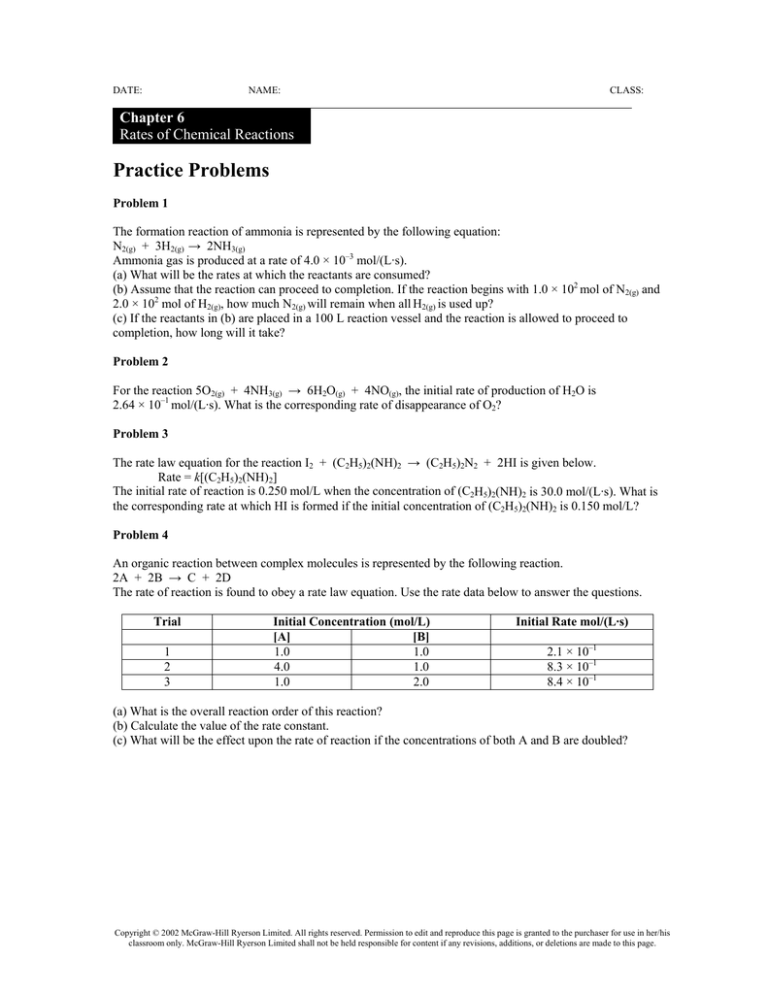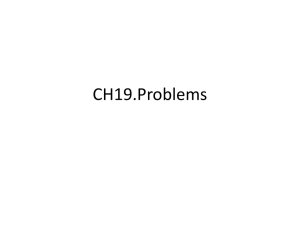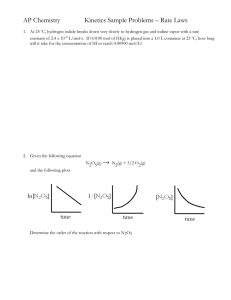
DATE:
NAME:
CLASS:
Chapter 6
Rates of Chemical Reactions
Practice Problems
Problem 1
The formation reaction of ammonia is represented by the following equation:
N2(g) + 3H2(g) → 2NH3(g)
Ammonia gas is produced at a rate of 4.0 × 10–3 mol/(L·s).
(a) What will be the rates at which the reactants are consumed?
(b) Assume that the reaction can proceed to completion. If the reaction begins with 1.0 × 102 mol of N2(g) and
2.0 × 102 mol of H2(g), how much N2(g) will remain when all H2(g) is used up?
(c) If the reactants in (b) are placed in a 100 L reaction vessel and the reaction is allowed to proceed to
completion, how long will it take?
Problem 2
For the reaction 5O2(g) + 4NH3(g) → 6H2O(g) + 4NO(g), the initial rate of production of H2O is
2.64 × 10–1 mol/(L·s). What is the corresponding rate of disappearance of O2?
Problem 3
The rate law equation for the reaction I2 + (C2H5)2(NH)2 → (C2H5)2N2 + 2HI is given below.
Rate = k[(C2H5)2(NH)2]
The initial rate of reaction is 0.250 mol/L when the concentration of (C2H5)2(NH)2 is 30.0 mol/(L·s). What is
the corresponding rate at which HI is formed if the initial concentration of (C2H5)2(NH)2 is 0.150 mol/L?
Problem 4
An organic reaction between complex molecules is represented by the following reaction.
2A + 2B → C + 2D
The rate of reaction is found to obey a rate law equation. Use the rate data below to answer the questions.
Trial
1
2
3
Initial Concentration (mol/L)
[A]
[B]
1.0
1.0
4.0
1.0
1.0
2.0
Initial Rate mol/(L·s)
2.1 × 10–1
8.3 × 10–1
8.4 × 10–1
(a) What is the overall reaction order of this reaction?
(b) Calculate the value of the rate constant.
(c) What will be the effect upon the rate of reaction if the concentrations of both A and B are doubled?
Copyright © 2002 McGraw-Hill Ryerson Limited. All rights reserved. Permission to edit and reproduce this page is granted to the purchaser for use in her/his
classroom only. McGraw-Hill Ryerson Limited shall not be held responsible for content if any revisions, additions, or deletions are made to this page.
Problem 5
Rate data for a reaction that is first order in [A] and first order in [B] are given in the table below. Complete
the table by determining the values that are blank.
Trial
1
2
3
4
5
Initial Concentration (mol/L)
[A]
[B]
0.12
0.75
0.12
1.50
—
0.75
0.48
—
0.36
1.50
Initial Rate mol/(L·s)
8.5 × 10–1
—
1.7
3.4
—
Problem 6
Rate data was collected for the following reaction in an aqueous solution.
Cr2+(aq) + Cu2+(aq) → Cr3+(aq) + Cu+(aq)
Trial
1
2
3
Initial Concentration (mol/L)
[Cr2+(aq)]
[Cu2+(aq)]
–3
2.0 × 10
1.5 × 10–3
–3
2.0 × 10
3.0 × 10–3
–3
4.0 × 10
1.5 × 10–3
Initial Rate mol/(L·s)
4.2 × 10–5
4.2 × 10–5
1.7 × 10–4
What will be the rate of reaction when [Cr2+(aq)] = [Cu2+(aq)] = 5.0 × 10–3 mol/L?
Problem 7
During a fermentation reaction, the initial concentration of the reactant decreases from 0.40 mol/L to 0.20
mol/L after 6.00 h, and then to 0.10 mol/L after 12.0 h. What is the rate constant for this fermentation?
Problem 8
The rate constant of a first order reaction is 7.71 × 10–4 s–1. How much of the reactant will remain after half an
hour?
Problem 9
Examine the potential energy diagram of a reaction that proceeds from reactant A to product D as shown.
Then, answer the accompanying questions.
(a) Is the overall reaction exothermic or endothermic?
(b) Which step is most likely to be the rate-determining step? Give a reason for your answer.
(c) Where would an activated complex be indicated on this diagram?
(d) What type of compound exists at B?
Copyright © 2002 McGraw-Hill Ryerson Limited. All rights reserved. Permission to edit and reproduce this page is granted to the purchaser for use in her/his
classroom only. McGraw-Hill Ryerson Limited shall not be held responsible for content if any revisions, additions, or deletions are made to this page.
Problem 10
A reaction mechanism is proposed for the reaction of hydrogen peroxide and ozone in the presence of a
chlorofluorocarbon.
(slow)
Step 1: H2O2 → H2O + O
Step 2: O + CF2Cl2 → ClO + CF2Cl
(fast)
(fast)
Step 3: ClO + O3 → Cl + 2O2
Step 4: Cl + CF2Cl → CF2Cl2
(fast)
(a) Which is the rate-determining step in this mechanism?
(b) Write an equation to represent the overall reaction.
(c) List any intermediates formed.
(d) What type of reagent is CF2Cl2 in this mechanism?
(e) What is the molecularity of the overall reaction?
Copyright © 2002 McGraw-Hill Ryerson Limited. All rights reserved. Permission to edit and reproduce this page is granted to the purchaser for use in her/his
classroom only. McGraw-Hill Ryerson Limited shall not be held responsible for content if any revisions, additions, or deletions are made to this page.
Answers
1.
3
× 4.0 × 10–3 mol/(L·s) = 6.0 × 10–3 mol/(L·s)
2
1
Rate of consumption of H2 =
× 4.0 × 10–3 mol/(L·s) = 2.0 × 10–3 mol/(L·s)
2
(a) Rate of consumption of H2 =
(b) To consume 2.0 × 102 mol of H2,
Amount of N2 consumed =
1
× 2.0 × 102 mol = 6.7 × 101 mol
3
Amount of N2 remaining = 1.0 × 102 mol – 6.7 × 101 mol = 3.3 × 101 mol
∆[H 2 ]
= 6.0 × 10–3 mol/(L·s)
∆t
2.0 × 10 2 mol
Since [H2]final = 0, ∆[H2] = [H2]initial =
= 2.0 mol/L
100 L
2.0 mol/L
∆t =
= 3.3 × 102 s
6.0 × 10 −3 mol/(L·s)
(c) Rate of reaction =
2.
5
× Rate of production of H2O
6
5
= × 2.64 × 10–1 mol/(L·s)
6
Rate of disappearance of O2 =
= 2.20 × 10–1 mol/(L·s)
3.
Rate = k[(C2H5)2(NH)2]
k=
30.0 mol/(L·s)
= 1.20 × 102 s–1
0.250 mol/L
When [(C2H5)2(NH)2] = 0.150 mol/L,
Rate = 1.20 × 102 s–1 × 0.150 mol/L
= 1.8 × 101 mol/(L·s)
Rate of formation of HI = 2 × Rate of disappearance of (C2H5)2(NH)2
= 2 × 1.8 × 101 mol/(L·s)
= 3.6 × 101 mol/(L·s)
4.
(a) From trials 1 and 2, when [B] is constant, [A] increases by a factor of 4, and the rate also increases by a
factor of 4. Therefore, rate α [A]. From trials 1 and 3, when [A] is constant, [B] increases by a factor of 2 and
the rate increases by a factor of 4, or 22. Therefore, rate α [B]2. The rate law equation for the reaction is:
Rate = k [A][B]2
The overall reaction order is 3.
(b) Using the data from trial 1,
k =
Rate
2.1 × 10 −1 mol/(L·s)
=
= 2.1 × 10–1 L2 /(mol2·s)
2
2
[A][B]
(1.0 mol/L)(1.0 mol/L)
Copyright © 2002 McGraw-Hill Ryerson Limited. All rights reserved. Permission to edit and reproduce this page is granted to the purchaser for use in her/his
classroom only. McGraw-Hill Ryerson Limited shall not be held responsible for content if any revisions, additions, or deletions are made to this page.
(c) If [A] and [B] are doubled, the rate of reaction will increase by a factor of [2][2]2, or 8.
5.
Rate = k [A][B]
Use the rate data for trial 1 for comparison.
Trial 2: When [A] is constant, [B] increases by a factor or 2. The rate also increases by 2. Rate = 1.7 mol/(L·s)
Trial 3: When [B] is constant, the rate increases by 2. [A] must have increased by 2. [A] = 0.24 mol/L
Trial 4: When [A] increases by 4, the rate also increases by 4. [B] must be unchanged. [B] = 0.75 mol/L
Trial 5: When [A] increases by 3 and [B] increases by 2, the rate increases by 6. Rate = 5.1 mol/(L·s)
6.
The rate law equation for the reaction has to be determined first.
Rate = k [Cr2+(aq)]m [Cu2+(aq)]n
Consider trials 1 and 2.
Rate 2
k [2.0 × 10 - 3 mol/L]m [3.0 × 10 - 3 mol/L]n
4.2 × 10 - 5 mol/(L·s)
=
=
Rate1
k [2.0 × 10 - 3 mol/L)]m [1.5 × 10 - 3 mol/L]n
4.2 × 10 - 5 mol/(L·s)
(2)n = 1
n = 0 (by inspection)
Consider trials 1 and 3.
Rate 3
k [4.0 × 10 - 3 mol/L]m
1.7 × 10 - 4 mol/(L·s)
=
=
Rate1 k [2.0 × 10 - 3 mol/L)]m
4.2 × 10 - 5 mol/(L·s)
(2)m = 4
m = 2 (by inspection)
Rate = k [Cr2+(aq)]2
In trial 1:
4.2 × 10–5 mol/(L·s) = k [2.0 × 10–3 mol/L]2
k = 10 L/(mol·s)
For [Cr2+(aq)] = 5.0 × 10–3 mol/L,
Rate = 10 L/(mol·s) × (5.0 × 10–3 mol/L)2 = 2.5 × 10–4 mol/(L·s)
7.
Rate = k [A]m
0.2 mol/L − 0.4 mol/L
− 0.2 mol/L
=
, when [A] = 0.4 mol/L
6.00 h − 0.00 h
6.00 h
− 0.1 mol/L
0.1 mol/L − 0.2 mol/L
Rate2 =
=
, when [A] = 0.2 mol/L
6.00 h
12.0 h − 6.00 h
Rate1 =
Since the rate is halved when the concentration is halved, m = 1, and the reaction is first order. For a first order
reaction,
0.693
k
0.693
k=
= 3.2 × 10–5 s–1
6.00 h
t1/2 =
8.
t1/2 = =
0.693
= 900 s = 15.0 min
7.71 × 10 −4 s −1
Half an hour is equal to two half-lives. Therefore, one-quarter, or 25 % of the reactant remains.
Copyright © 2002 McGraw-Hill Ryerson Limited. All rights reserved. Permission to edit and reproduce this page is granted to the purchaser for use in her/his
classroom only. McGraw-Hill Ryerson Limited shall not be held responsible for content if any revisions, additions, or deletions are made to this page.
9.
(a) endothermic
(b) Step 2 is the rate-determining step because it requires the highest activation energy.
(c) E, F, or G
(d) reaction intermediate
10.
(a) Step 1
(b) H2O2 + O3 → H2O + 2O2
(c) O, ClO, CF2Cl, Cl
(d) catalyst
(e) 2
Copyright © 2002 McGraw-Hill Ryerson Limited. All rights reserved. Permission to edit and reproduce this page is granted to the purchaser for use in her/his
classroom only. McGraw-Hill Ryerson Limited shall not be held responsible for content if any revisions, additions, or deletions are made to this page.




